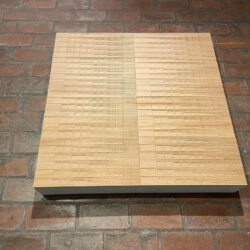Their coming and going in Vienna has inevitably shaped these works and their creators. However, Schubert’s eponymous song cycle is not a direct allusion, but rather an interpretive framework for the works on display, which helps to invite the audience on an imaginary journey.
Two of the most influential artists of their generation, Zsolt Tibor and Júlia Vécsei, have built a consistent creative praxis based on drawing. Their current joint exhibition at the Budapest Gallery reveals the many parallels between their creative practices: beyond the basic principles of drawing, the importance of manual techniques (gluing, applying, copying, blowing); the fascination with drawing tools (carbon paper, graph paper, ink pencil, ruler); the particular character of pale, blurred forms and pencil lines; the sense of contingency, the special role of chance or absence are emphasised in both their oeuvres.
Both artists are fond of drawing on and being inspired by the motifs, objects and memories of childhood: the figure of the parent or grandparent lingers in the duct tape structures, the purple ink pencil, the lines of the clock hand, or the use of indigo. Repetition, symmetry, mirroring as compositional techniques or, more generally, playful yet serene works that avoid personality and narrative are specific to both oeuvres. Beyond the pleasure of discovering similarities, however, the exhibition’s concept is not formulated in terms of a coordinate system of parallels and differences.
For while Tibor’s large-scale motifs, which seem randomly scattered against a white background, are imbued with transcendent, spiritual content, Vécsei’s works, painted in featherlight lines and gradients or arranged in geometric patterns, reveal a philosophical approach. But it is just as true the other way round: in the same way that Tibor’s tiny, perfect pencil drawings evince an engineer’s precision, so can we discover poetry in Vécsei’s delicately hovering bird and deer figures.
At the current exhibition, the artists’ latest works, most of which were created for this show, explore such key concepts as time and timelessness, cyclicality and memory.


